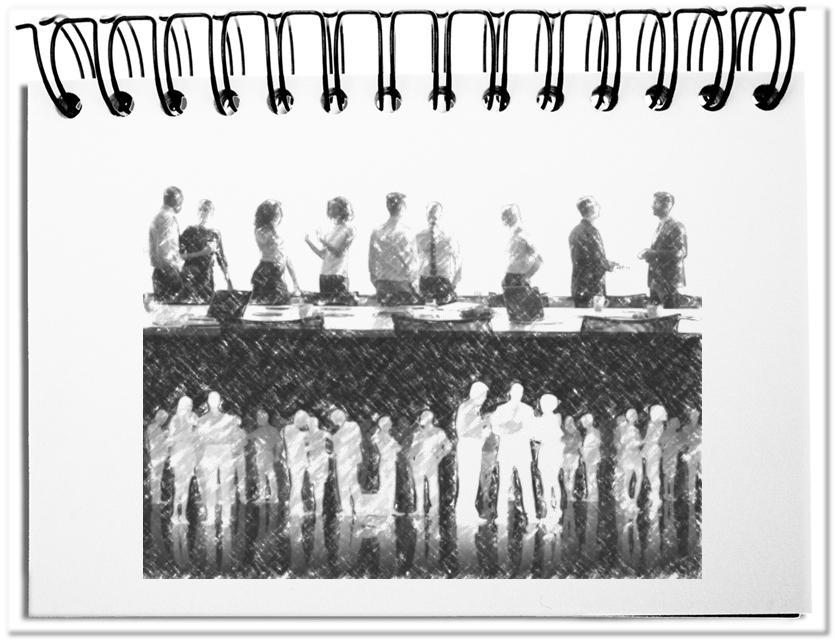Sometimes we let inspirations vanish unused that seem to come out of nowhere and strike like lightning, although we desperately search for them on another occasion. A eureka simply takes time to evolve. The paradoxical request to have a spontaneous idea prevents more than it provides ideas. With increasing agility, however, the expectation rises that employees will deliver solutions in short cycles, called sprints. This requires means to stimulate recognition.
An important engine for our capability to find something new is our perception. It is always active and receives stimuli at any time and simultaneously through any sense. Once you have become aware of the stimulating buttons, thinking creates results that are promising for the current task. Let’s take a look at the five channels (in short: VAKOG) that are available to us in order to simply attentively trigger the charging flashes of inspiration.
Visual (V)
At 40 Bit/sec, our vision is the sense with the greatest bandwidth. You can see that way the light of a candle across many kilometers in a dark night. With this sense we receive forms and colors. Use this channel as follows:
- Change the viewing direction!
- Surf through unknown websites, magazines and illustrated books!
- Close your eyes for a minute and notice after opening the eyes the changes in the environment!
- After that: Discover the emerging thoughts and connect them with your current task!
Auditive (A)
Our hearing still manages 30 Bit/sec. It allows us to hear the ticking of a clock from more than six meters. Hereby noises and rhythms, sounds and music as well as speech are perceived. This channel can be provoked as follows:
- Close your eyes now or take a little walk and listen!
- Find a sound that sticks out or that you like to hear!
- Start a canned music and let your thoughts drift.
- After that: Notice the emerging thoughts and connect them with the current task!
Kinesthetic (K)
We feel with our body 5 Bit/sec. This is enough to feel a bee’s wing falling on our cheek from 1cm. The fingertips distinguish surfaces and edges. Our body perceives fluctuations in temperature before we become aware of them. We feel the position and movement of our body and react with pains to thermal, mechanical and chemical stress. These channels can be used in the following way:
- Just close your eyes and strike over a reachable surface!
- Feel the temperature of a heat source near you or in the sun!
- Stand up, take a lap and feel your body – the feet, the knees, the back, the shoulders, the neck and whatever!
- After that: Notice the emerging thoughts and connect them with the current task!
Olfactory (O)
Even though our nose only has a speed of more than 1 Bit/sec. bandwidth, you can still smell a drop of perfume in a three-room apartment:
- Close your eyes and sniff your surroundings!
- Get up, take a walk through your immediate surroundings and pay attention to the smells in the different places!
- Take a splash of perfume or enjoy the smell of fresh coffee!
- After that: Notice the emerging thoughts and connect them with the current task!
Gustatory (G)
The taste buds work closely with the nose and have a bandwidth of 1 Bit/sec. With this we taste another teaspoon of sugar dissolved in 7.5 liter of water:
- Close your eyes and taste your surroundings!
- Use a small snack or coffee to bring about a change in your taste!
- Try something completely different or even unloved!
- After that: Notice the emerging thoughts and connect them with the current task!
Bottom line: All senses are always active and receive stimuli from the environment without our continuous attention. Of the 100% stimuli that our senses absorb, only 10% become conscious. More would drive us mad. However, we can activate perception and fire our thinking. The concentration on single or multiple channels provides us with a completely new view of the world – and offers us the desired stimulations of our thinking, which release our inspirations from the subconscious and would otherwise not be easily reachable. Thus, the VAKOG channels offer a possibility to stimulate our recognition and to reach spontaneous insights.


